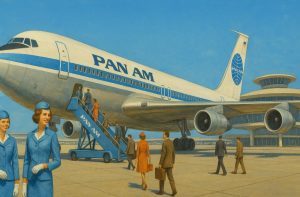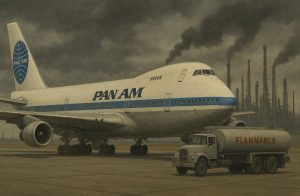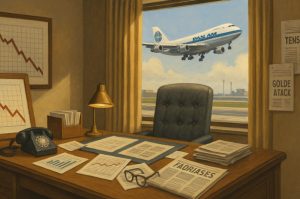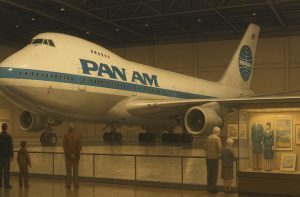For much of the 20th century, Pan American World Airways was the embodiment of luxury, innovation, and global air travel. Often referred to simply as Pan Am, the airline was once the largest international air carrier in the United States and was globally recognised as a symbol of American excellence.
However, despite its pioneering spirit and influence on the aviation industry, the airline filed for bankruptcy in 1991 and ceased operations soon after.
So, what led to the collapse of this iconic airline? To understand why Pan Am went out of business, we must examine its operational history, strategic decisions, economic pressures, and global events that reshaped the aviation landscape.
What Made Pan Am a Giant in Aviation History?

Pan Am’s roots trace back to 1927, when it operated a mail service between Key West, Florida, and Havana, Cuba. Over the next few decades, it evolved into an international powerhouse.
By mid-century, Pan Am was a household name, representing the golden age of air travel. The airline introduced several groundbreaking developments that changed commercial aviation forever.
Pan Am was responsible for bringing long-haul jet travel to the masses. Its influence was so significant that the introduction of the Boeing 707 in 1958 and later the Boeing 747 in 1970 were both closely associated with the airline.
In fact, Pan Am played a key role in the design and development of the 747, which would become the flagship aircraft of its fleet.
The airline also pioneered:
- The use of computerised reservation systems, starting in 1964
- Professional flight crew and cabin crew training standards
- The concept of a hub-and-spoke route model
- Signature terminals like the Worldport at JFK, which became architectural icons of air travel
Pan Am was a leader, trendsetter, and visionary. However, as the airline grew in scale, so did its vulnerabilities.
How Did Airline Deregulation Impact Pan Am’s Business Model?
A major turning point came in 1978 with the introduction of the Airline Deregulation Act in the United States. Prior to deregulation, the Civil Aeronautics Board tightly controlled airline routes, fares, and market entry, particularly on domestic routes.
Pan Am, which had focused almost exclusively on international flights and had no domestic network to fall back on, was immediately at a disadvantage.
With deregulation, new competitors, many of them low-cost startups, entered the market and began offering cheaper fares on domestic routes.
This forced legacy carriers to match pricing, squeezing profit margins across the industry. Carriers like Southwest Airlines thrived under these new conditions by embracing lean operations and a simplified business model.
Pan Am, on the other hand, was left exposed. Its costs remained high, and without a strong domestic network to feed passengers into its international hubs, the airline struggled to maintain competitiveness.
It made a belated attempt to adapt by acquiring National Airlines in 1980, hoping to build a domestic presence, but this decision proved to be one of several financial missteps that accelerated its downfall.
How Did Economic Crises Affect Pan Am in the 1970s and 1980s?

In addition to deregulation, the oil crisis of the 1970s placed a massive financial burden on the aviation industry.
The first crisis in 1973, triggered by an oil embargo by OAPEC, caused fuel prices to spike. For Pan Am, which operated long-haul international flights requiring more fuel, the increase in fuel costs was devastating.
Jet fuel prices surged dramatically, adding an estimated $200 million to Pan Am’s annual operational expenses after the embargo.
The airline had just invested heavily in its fleet of Boeing 747s, expecting growing demand for international travel. However, the surge in fuel costs coincided with a drop in consumer demand, especially for transatlantic travel, as airlines were forced to raise fares to cover costs.
The airline was caught in a bind its operating model was based on a high-capacity, high-cost structure, but the market environment now demanded leaner, more flexible operations.
By the early 1980s, it was clear that Pan Am’s financial model no longer aligned with the realities of the industry.
What Were the Consequences of Pan Am’s Strategic Mistakes?
Perhaps the most cited strategic error in Pan Am’s history was its acquisition of National Airlines. The $437 million purchase was meant to provide Pan Am with a much-needed domestic network.
However, the merger was poorly executed. There were differences in corporate cultures, incompatible systems, and a lack of synergy between the two airlines.
Rather than enhancing Pan Am’s position, the acquisition added to its financial burden. Integration issues meant that operational costs rose without a corresponding increase in revenue.
In essence, Pan Am paid a premium for a network that did not support its global hubs effectively.
To stay afloat during the 1980s, Pan Am began selling off its most valuable assets:
| Year | Asset Sold | Buyer | Significance |
| 1985 | Pan Am Building (NYC) | Metropolitan Life | Sold for $400 million to raise capital |
| 1986 | Pacific Division | United Airlines | Included aircraft, routes, and staff |
| 1990 | London Heathrow Routes | United Airlines | One of Pan Am’s most profitable markets |
These were desperate measures aimed at preserving liquidity, but they ultimately left Pan Am without the critical infrastructure that had made it great.
How Did the Lockerbie Bombing Damage Pan Am’s Reputation?
On 21 December 1988, Pan Am Flight 103 exploded over Lockerbie, Scotland, as a result of a terrorist bombing.
All 270 people on board and on the ground were killed. The disaster shocked the world and became one of the deadliest aviation incidents in history.
For Pan Am, the consequences were not only emotional and moral but also financial and operational. Investigations revealed security lapses, and the airline was fined by the FAA for 19 separate violations.
Additionally, Pan Am faced a $300 million lawsuit from victims’ families and insurance companies. The tragedy accelerated the erosion of public confidence in the airline.
Already weakened by poor financial decisions and deregulation, Pan Am now faced intense scrutiny, plummeting ticket sales, and soaring legal costs. The airline struggled to restore its image, but the damage was irreversible.
Did Pan Am Attempt to Restructure Before Declaring Bankruptcy?

In the final years before its collapse, Pan Am sought to restructure its business through asset sales, partnerships, and operational cutbacks.
In 1991, the airline filed for Chapter 11 bankruptcy protection. Chairman Thomas Plaskett expressed optimism, stating that the move was a “fresh start” and an opportunity to restructure in a highly competitive industry.
Unfortunately, restructuring efforts came too late. Delta Air Lines acquired Pan Am’s transatlantic routes and shuttle service shortly before the final shutdown.
Even with $150 million in financial backing, the airline continued to lose millions each day.
On 4 December 1991, after 64 years in operation, Pan Am ceased all services. Approximately 7,500 employees lost their jobs, and the world said goodbye to one of the most iconic names in aviation history.
Was Pan Am’s Collapse Part of a Larger Industry Trend?
Yes, Pan Am was not alone in its struggle. The late 20th century was a period of intense upheaval in the airline industry. Deregulation, economic instability, and global crises forced several airlines into bankruptcy or liquidation.
Among those that collapsed during this era:
- Continental Airlines (filed for reorganisation a month before Pan Am)
- Eastern Air Lines
- Braniff International
- Presidential Airlines
- Capitol Air
- Pacific Southwest Airlines
These airlines, like Pan Am, faced the dual challenge of high operating costs and rapidly changing market dynamics. The playing field had shifted, and only the most agile carriers survived.
What Is the Enduring Legacy of Pan Am?

Despite its fall, Pan Am’s contributions to aviation remain substantial. It helped shape the international aviation industry as we know it today.
The Boeing 747, a product of Pan Am’s vision and investment, revolutionised long-distance travel. In many ways, the modern aviation industry owes a debt to Pan Am for its bold ideas and pioneering technology.
Today, Pan Am lives on in museums, cultural references, and nostalgic memories.
A former Pan Am Boeing 747 in Sweden has been converted into a hostel, and other aircraft are on display at institutions like the Evergreen Aviation & Space Museum in Oregon.
Perhaps more importantly, Pan Am serves as a case study in business strategy, demonstrating how even the most powerful entities can fall if they fail to adapt to changing circumstances.
Frequently Asked Questions (FAQs)
Why did Pan Am declare bankruptcy in 1991?
The airline filed for bankruptcy due to a combination of economic pressures, poor management decisions, deregulation, and reputational damage following the Lockerbie disaster.
Was Pan Am a profitable airline before its decline?
Yes, during the mid-20th century, Pan Am was a profitable and prestigious carrier. However, changing market conditions eroded its profitability in the 1970s and 1980s.
What was the significance of the Boeing 747 to Pan Am?
Pan Am played a major role in the development of the 747 and became the first airline to fly it commercially. The aircraft became a symbol of long-haul travel and Pan Am’s global reach.
How did the acquisition of National Airlines affect Pan Am?
The merger was intended to strengthen domestic routes but failed due to poor integration and high acquisition costs, weakening Pan Am’s financial position.
Did other airlines try to buy parts of Pan Am?
Yes, Delta Air Lines purchased its transatlantic routes and shuttle services shortly before the collapse. Other carriers like United and American also expressed interest.
Was Pan Am unique in facing such a collapse?
No. Many airlines during the same period, including Eastern, Braniff, and Continental, faced bankruptcy due to similar economic and industry challenges.
What can modern airlines learn from Pan Am’s downfall?
Modern carriers can learn the importance of operational efficiency, adaptability, and strategic foresight. Success in aviation is not only about size but also agility and resilience.






